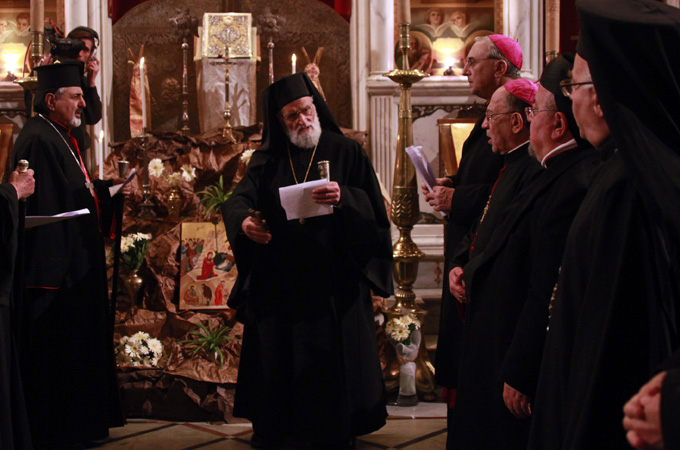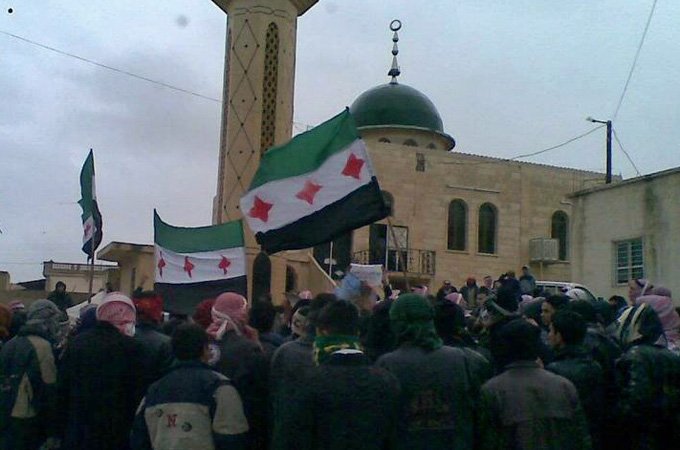Q&A: Nir Rosen on Syrian sectarianism
Journalist who recently spent time with Syria’s diverse communities describes growing divides in society.

 |
| Around 75 per cent of Syria’s population are Sunni Muslims, but President Assad (C) belongs to the Alawite sect [SANA] |
Journalist Nir Rosen recently spent two months in Syria. As well as meeting members of various communities across the country – supporters of the country’s rulers and of the opposition alike – he spent time with armed resistance groups in Homs, Idlib, Deraa, and Damascus suburbs. He also travelled extensively around the country last year, documenting his experiences for Al Jazeera.
This is the third in a series of interviews he gave to Al Jazeera since his return. Catch up by reading his comments on Syria’s armed opposition and the country’s protest movement.
Al Jazeera: Was Syria divided along sectarian lines before protests began?
Nir Rosen: Syrians, like most people in the Middle East, are influenced by sectarianism. These forms of prejudice, however, are not unique to the Arab world. Across the region, sectarian tensions have increased since the 2003 invasion of Iraq and the conflict it set off between the Sunni and Shia there.
In my journeys in Syria, members of Sunni communities have told me they came to resent Alawites – a heterodox sect which practices elements of Shia Islam – after the rise of the Alawite Assad dynasty. Some of this was due to prejudice against Alawites and some due to urban prejudice against those from rural backgrounds.
Many among the Sunni in Syria also believe that Alawites are disproportionately represented in the security forces, as well as in various government positions, especially the most sensitive ones.
Likewise, many Alawites fear being marginalised – or worse – by the country’s Sunni majority.
AJ: Has this changed during the uprising?
NR: Since the crisis started, sectarian fears have grown. The security crackdown and the loyalty most Alawites have to the regime have also increased anti-Alawite sentiment. The security forces, those shooting, arresting, abusing and killing citizens – opposition activists or even random Sunni citizens – speak with Alawite accents, say the opposition.
In parts of Homs, Damascus and Latakia, there is a feeling among Sunni communities that pro-regime militia, the shabiha [“thugs”], have been recruited from among the general Alawite population. Anger has increased and it is common to hear anti-government Sunnis condemning all Alawites.
Many Christians also now fear a rise of the Sunni majority. But I have never heard any resentment towards Christians or the Druze or Ismaili minorities from Sunni opposition I have spoken with.
The rhetoric of the ultra conservative anti-regime cleric Adnan al-Arur, who is based in Saudi Arabia, has terrified many Alawites and other minorities.
Many people in Syria now try to figure out where somebody is from and to which sect they belong in order to assess whether somebody is a friend of foe. Sometimes people change their accent to try to hide or protect their identity.
Interestingly, anti-Shia feelings among the opposition are more predominant than anywhere I have ever been, even though there are few Shia in Syria. This is mostly a response to the support, whether material or rhetorical, that the regime receives from Lebanon’s Hezbollah and from Iran – and the betrayal many Sunni opposition supporters feel over Hezbollah’s siding with Assad.
AJ: Is the opposition making efforts to prevent sectarian strife?
NR: In every anti-government demonstration there are anti-sectarian slogans and speeches. The opposition is very sensitive to the regime’s charges that it is a sectarian Sunni-Islamist movement.
AJ: Do religious minorities participate in protests?
NR: In Damascus, and sometimes in Homs, there are delegations of Alawite, Christian, Druze and Ismaili activists who may join Sunni demonstrators to show their solidarity. They are met with great fanfare and cheers.
 |
| Patriarchs in Damascus have held vigils in support of Assad and in memory of those killed [EPA] |
I met a group of Alawite activists who were doing their best to show the opposition that many Alawites support them. But minorities, especially Alawites, do not have the benefit of a community that supports and protects those who show their opposition, and they are often not fully trusted by the Sunni.
I have been to many demonstrations in Damascus where groups of Ismaili youth from Salamiyah, Druze from Suweida and others took part. On December 31, a delegation of Alawite activists joined about 500 Sunni demonstrators in the Damascus neighbourhood of Barzeh.
The leader of the demonstration announced to the crowd that they had special guests that evening. One man took the microphone and told the crowd he was an Alawite from Homs. The demonstrators cheered and clapped. He told them there were other Alawites in the crowd and many Alawites “in the prisons of the dog called Bashar al-Assad”. The crowds cheered and clapped again, and continued doing so after he shouted: “I am from the Alawite sect – not from the Assadi sect.” He led the crowd in chanting: “One, one, one, the Syrian people is one!” and “the people want the execution of Bashar!”
AJ: Does Islam play a role in the uprising?
NR: Undeniably, Islam is playing a role in the revolution. The majority of Syria’s population is Sunni Muslim – and so are most of the opposition.
In some parts of Syria there were Islamist-inspired revolts from the 1960s until 1982, when the late President Hafez al-Assad crushed a rebellion in the so-called Hama massacre. Some taking part in the current uprising are children or relatives of Muslim Brotherhood members from the 1980s.
But very few in the opposition are struggling for an “Islamic state”. They say Islam is not “the goal”. It does, however, provide a creed or inspiration and it colours the discourse for many protesters and fighters. In part this is natural. People will refer to their local culture and history and values when struggling for political goals. This is especially true if they are devout and their struggle involves great risks.
I have been to about 100 demonstrations in Syria. In many of them I had to run for my life from live gunfire. I was terrified.
The demonstrators who have been going out every day since March know they are risking their lives. It helps them to believe in paradise and martyrdom.
Many youth who didn’t pray before the revolution, who may have smoked hashish or drank alcohol – both banned in Islam – have become more devout and have forsaken their liberal or secular ways, inspired by the cycle of demonstrations emerging from mosques, of funerals and “martyrs” and the new cause they have discovered. It is very common for demonstrations to include the recitation of the fatiha (opening) verses from the Quran – but I have also met many secular activists.
AJ: Are Islamist movements influential in Syria?
 |
| Protests often start outside mosques after prayers [LCC] |
NR: The regime and its supporters describe the opposition, especially the armed opposition, as Salafis, Jihadists, Muslim Brotherhood supporters, al-Qaeda and terrorists. This is not true. The Salafi and Muslim Brotherhood ideologies are not important in Syria and do not play a significant role in the revolution.
There is some sense of Sunni communal identity, inspiring many of the demonstrators. I believe that the longer this drags on, the more important the role of Islamists will be. Already in several areas you can hear demonstrators chanting for a declaration of jihad, chanting about Muslims and infidels, referring to the Quran more and more. Sometimes they sing the praises of the sectarian firebrand cleric Adnan al-Arur.
AJ: What role do mosques and religious sheikhs play?
NR: Initially, demonstrators tried to gather in public squares but they were denied any place to gather except for mosques. This naturally gave the mosques a greater role than they would otherwise have had. During Ramadan after the tarawih prayers, or on Fridays after the noon prayer, the thunderous chants of “God is great” begin in the mosque, building one’s courage, like an army preparing to charge out of the mosque into danger.
Some sheikhs did play a role in encouraging youth to go out, leading them, inspiring them, maintaining their discipline – and in some cases even leading armed insurgent groups.
AJ: Do you predict a deepening sectarian divide?
NR: The longer the conflict drags on, the more likely it is to devolve into a battle of Sunni militia fighting Alawite militia. Both sides will become further radicalised as fear of extermination will likely lead to pre-emptive attacks and then revenge attacks.
The opposition has failed to reassure Alawites that they have a safe future in a post-Assad Syria. Most Alawite homes have somebody working in the security forces and they are also disproportionately represented in other government jobs. They fear collective punishment and losing their jobs. If the regime collapses, many will flee back to the mountain or coastal villages they came from.
At the same time, Sunni residents who are a minority in parts of Latakia, especially in the mountain villages, may also face displacement. I believe a civil war is inevitable.
The insurgents will carve out more autonomous zones and those pockets of pro-regime supporters, especially if they are Alawite, will fight or flee. I already know of many Christians and Alawites who have fled from Homs. Alawite neighbourhoods in Homs or Damascus associated with the security forces may be subject to revenge attacks.
Members of the security forces might choose to stay in their villages or neighbourhoods out of self-defence and parts of Syria will be caught up in sectarian conflict.
Look out for more interviews and features from Nir Rosen to be published here on Al Jazeera over the rest of this week.
Follow Nir Rosen on Twitter: @NirRosen
The views expressed in this article are those of whom to which they have been attributed and do not necessarily reflect Al Jazeera’s editorial policy.